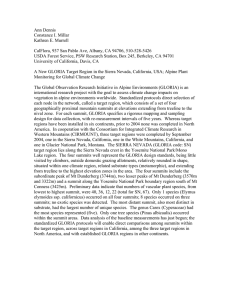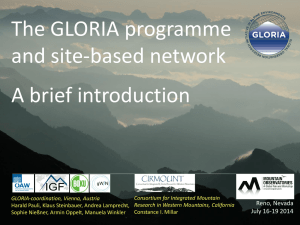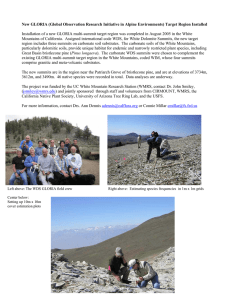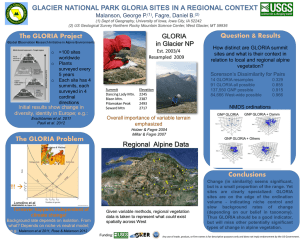Document 13574552
advertisement
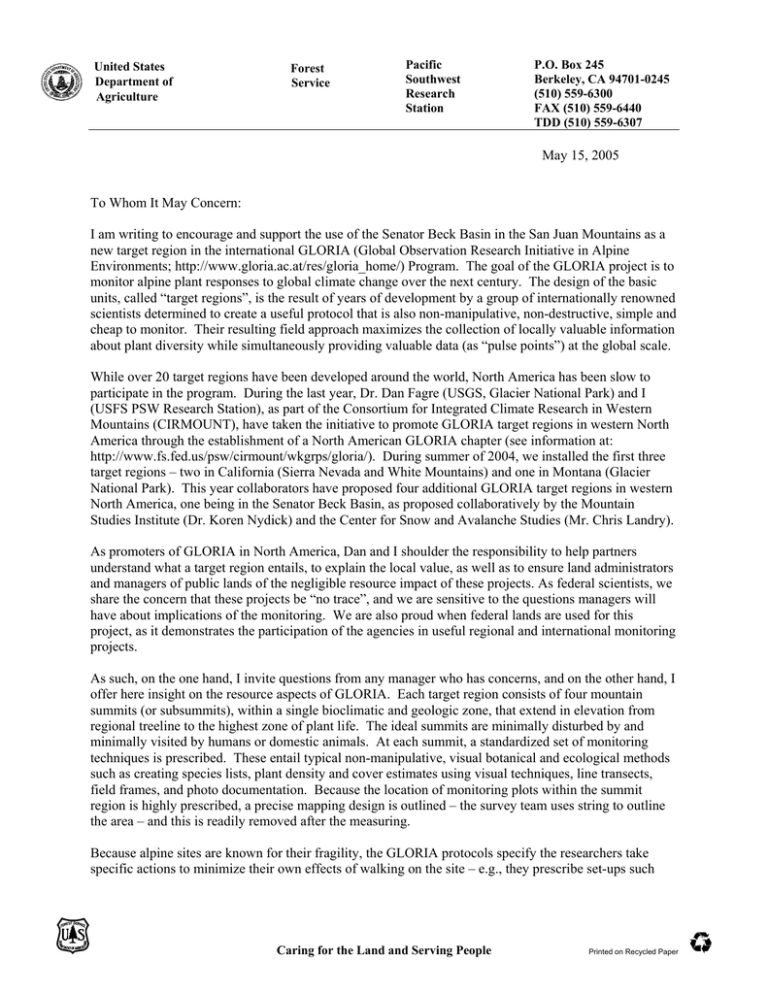
United States Department of Agriculture Forest Service Pacific Southwest Research Station P.O. Box 245 Berkeley, CA 94701-0245 (510) 559-6300 FAX (510) 559-6440 TDD (510) 559-6307 May 15, 2005 To Whom It May Concern: I am writing to encourage and support the use of the Senator Beck Basin in the San Juan Mountains as a new target region in the international GLORIA (Global Observation Research Initiative in Alpine Environments; http://www.gloria.ac.at/res/gloria_home/) Program. The goal of the GLORIA project is to monitor alpine plant responses to global climate change over the next century. The design of the basic units, called “target regions”, is the result of years of development by a group of internationally renowned scientists determined to create a useful protocol that is also non-manipulative, non-destructive, simple and cheap to monitor. Their resulting field approach maximizes the collection of locally valuable information about plant diversity while simultaneously providing valuable data (as “pulse points”) at the global scale. While over 20 target regions have been developed around the world, North America has been slow to participate in the program. During the last year, Dr. Dan Fagre (USGS, Glacier National Park) and I (USFS PSW Research Station), as part of the Consortium for Integrated Climate Research in Western Mountains (CIRMOUNT), have taken the initiative to promote GLORIA target regions in western North America through the establishment of a North American GLORIA chapter (see information at: http://www.fs.fed.us/psw/cirmount/wkgrps/gloria/). During summer of 2004, we installed the first three target regions – two in California (Sierra Nevada and White Mountains) and one in Montana (Glacier National Park). This year collaborators have proposed four additional GLORIA target regions in western North America, one being in the Senator Beck Basin, as proposed collaboratively by the Mountain Studies Institute (Dr. Koren Nydick) and the Center for Snow and Avalanche Studies (Mr. Chris Landry). As promoters of GLORIA in North America, Dan and I shoulder the responsibility to help partners understand what a target region entails, to explain the local value, as well as to ensure land administrators and managers of public lands of the negligible resource impact of these projects. As federal scientists, we share the concern that these projects be “no trace”, and we are sensitive to the questions managers will have about implications of the monitoring. We are also proud when federal lands are used for this project, as it demonstrates the participation of the agencies in useful regional and international monitoring projects. As such, on the one hand, I invite questions from any manager who has concerns, and on the other hand, I offer here insight on the resource aspects of GLORIA. Each target region consists of four mountain summits (or subsummits), within a single bioclimatic and geologic zone, that extend in elevation from regional treeline to the highest zone of plant life. The ideal summits are minimally disturbed by and minimally visited by humans or domestic animals. At each summit, a standardized set of monitoring techniques is prescribed. These entail typical non-manipulative, visual botanical and ecological methods such as creating species lists, plant density and cover estimates using visual techniques, line transects, field frames, and photo documentation. Because the location of monitoring plots within the summit region is highly prescribed, a precise mapping design is outlined – the survey team uses string to outline the area – and this is readily removed after the measuring. Because alpine sites are known for their fragility, the GLORIA protocols specify the researchers take specific actions to minimize their own effects of walking on the site – e.g., they prescribe set-ups such Caring for the Land and Serving People Printed on Recycled Paper 2 that researchers walk only on rock and avoid the plant areas. Low impact by researchers is a key to the success of the analysis, so this advice has high likelihood of being followed. The entire technique is intended to be conducted under the rigorous conditions of mountain summits, and thus is quite “low-tech”. In our experience, a team of 4 field staff can complete the monitoring of a single summit in 2-5 days, and the impact is virtually nil. Once the four summits are measured, the sites are not remonitored for five years. In our experience, the sum of potential resource impacts is as follows: * Permanent marking. The highest summit point is recommended to be permanently marked. We have used three methods: a small (2” dia) spot of permanent paint, or a etched (2” dia) “X” on a rock. Alternately a precise GPS point could be substituted. Additional plots on each summit are recommended for permanently monitoring – GPS documentation may be adequate if there is a concern for paint or other physical marker. * Temperature dataloggers. Four dataloggers per summit site are buried 10 cm below the surface in prescribed locations. These are very small instruments (1” diameter, 0.5” thick) and the design specifies that the hole be filled as close to the original condition as possible. These locations are not externally marked. They are dug up during remonitoring and information downloaded. * Trampling from researchers. As above, this is minimized by the prescribed technique, the small number of people needed, and the size of the plots. In our experience, the effect is negligible. Finally, I would mention to partners in the USFS National Forest System that special use permits (SUP) may not be necessary. While national forests have varying needs for SUPs, if it would help to have my name as a co-sponsor listed on a project in the San Juan Mountains, I would be happy to participate. That is how we proceeded in USFS Regions 4 and 5: as I was the sponsor of GLORIA target regions on the Inyo National Forest and Humboldt-Toiyabe, the local Forest staff felt there was not a need for SUPs for these projects. I would be happy to pass the names of the local national forest staff to others if that would expedite and simplify permitting. On the other hand, if a SUP is deemed necessary, I would be happy to assist if there is a way to clarify questions about methods and minimize the time required for staff to complete the permit. Dan Fagre and I are encouraged to have the interest from Dr. Nydick and Mr. Landry in the San Juans. I am pleased to work with them and the local land managers to initiate this valuable project. Please call on either Dan or I if we can be of help. /Connie Millar/ CONSTANCE I. MILLAR Senior Research Scientist Sierra Nevada Research Center ph: 510-559-6435, email: cmillar@fs.fed.us cc: Dan Fagre, Chris Landry, Koren Nydick

